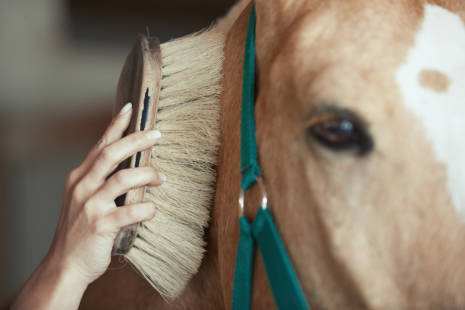Tuesday 20th November, 2018

Grooming is an important part of horse care, however we need to be mindful that our grooming routine must change with the seasons. Winter weather means thick coats and muddy rugs, which can make grooming a rather tricky task. There is nothing like seeing a sheen on your horse’s coat in the summer, but should we groom as vigorously in the winter? The short answer is no, so read on to find out why.
The act of grooming is to remove mud and dirt from your horse’s coat, mane and tail. This prevents matting, which can result in sores. Brushing also improves circulation while stimulating sebum production from within the hair follicles. Grooming is a powerful way to gain your horse’s trust and build relationship, because it mimics the act of grooming within the herd. Horses are incredibly sensitive, tactile creatures that enjoy closeness with their stablemates and owners alike.
Your horse needs a thorough check over on a daily basis, to include hoof picking and removing gross mud. However, as the seasons change so too do the grooming needs of your horse, and you won’t need to fully groom every day. During the winter your horse’s coat becomes extra thick and produces more oils to protect them from the elements. Overgrooming can actually strip these precious oils and extra hairs from the coat, leaving it in poor condition.
In the winter, horses can often become very dirty due to wet weather and muddy fields. When bringing them in, simply remove the gross mud and dirt with a dandy brush or a rubber curry comb, paying special attention to the fetlocks. If your horse’s legs are particularly bad then you will need to wash them, but make sure they are dried off before stabling so he doesn’t get a chill.
You can give your horse a full groom once a week using the dandy brush followed by a body brush. Using long sweeping strokes, the body brush wicks away micro dust and stimulates sebum-producing follicles for a healthy shine. Keep manes and tails a little shorter than usual to prevent them getting mud-covered and matted. Use a wide toothed mane comb and some equine detangle spray to gently tease out any knots.
Finally, make sure that your horse’s feet are well looked after during the winter. Gateways and thoroughfares can become quagmires, which puts your horse at risk of developing mud fever. Always run your hands down your horse’s legs to check for heat and swelling and wash and dry fetlocks regularly. Pick your horses hooves daily to remove any stones or mud from the frog and sole that could cause discomfort.